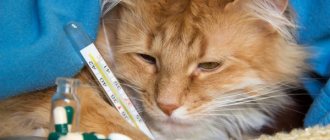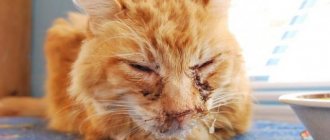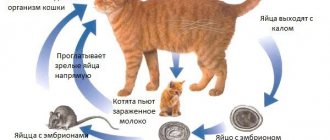One of the most dangerous diseases in cats is viral leukemia, which is highly contagious and can be fatal. This retroviral pathology is a latent, indolent disease and begins to actively manifest itself in the terminal phase, rapidly progressing.
1) Causative agent of leukemia and pathogenesis
2) Routes of infection
3) Signs of leukemia in cats
4) Diagnosis of the disease
5) Treatment
6) Prevention
Course of the disease
This infection has a chronic and active form. With weak immunity, the disease becomes active. Animals cannot overcome this virus, and within 2–4 months pathologies develop, leading to death. Some cats develop temporary viremia . This is a condition when a sufficiently strong pet’s immunity partially clears the blood of the virus, but the viral agent remains in the bone marrow and lymphocytes (cells of the immune system). As a result of stress or another illness, the virus can become active again. Only 20% of infected cats fully recover, and the process can take up to 1 year. Also, with leukemia, the animal cannot overcome other viral infections, and they can also become chronic.
Pathogenesis
The virus replicates inside the cells of the pharynx and nasal cavity, primarily in the tonsils. From there, the infection spreads through the lymph, affecting the bone marrow. Most animals at this stage exhibit an active immune system response, which stops the spread of infection. In some individuals, the disease continues to be latent, while the presence of virions inside the bone marrow tissue remains.
If pathogen replication occurs more intensively, this leads to infection entering the circulatory system. Next, viral organisms spread through the bloodstream through lymph tissues, respiratory organs, and salivary glands. At the stage described, the virus is released into the external environment and spreads to other carriers. If the cat’s body forms an intense immune response, the virus stops actively multiplying, but is present in the blood for a period of time from two days to two months.
Cats whose bodies cannot cope with the virus experience progressive infection. A sick animal exhibits a complex of signs of the disease and infects other animals upon contact. The course of the disease depends on the age, state of the immune system and the number of infectious virions that have entered the body of the furry patient.
How does feline leukemia virus become infected?
FeLV transmission occurs in several ways:
- Through contact when the virus is shed in urine, feces, milk, saliva or through contact with the oral mucosa of infected cats.
- In utero , when the virus passes through the placenta to the developing embryo.
- Iatrogenically , that is, through contaminated needles, instruments and through blood transfusion from an infected animal.
Is there a danger to humans?
Detailed studies reliably confirm that infection of human leukemia from a cat is impossible. The virus cannot attach to human DNA, since the structure of this molecule is different in humans and cats. Virion will not be able to find fragments suitable for attachment. Leukemia in humans is of a non-viral nature. Dogs are not susceptible to VLK for a similar reason. Therefore, an infected cat does not pose a danger to people or dogs.
Is feline leukemia dangerous for people?
The leukemia virus is not known to be transmitted to humans. However, cats with this disease can carry other infections that are transmitted to people with weakened immune systems (for example, patients with HIV/AIDS, people undergoing chemotherapy, etc.). Therefore, cats with leukemia should be kept under observation. If symptoms of any disease become apparent, they should be taken to a veterinarian for immediate examination. This is necessary both for the cat itself and for any person living with it.
Cats with the chronic form usually appear healthy. And they are especially dangerous because no one suspects that a pet is a carrier and distributor of the virus.
Therefore, it is recommended to diagnose this disease in cats that are at risk or have owners with weakened immune systems.
Prevention
We all know that prevention is better than cure. And in the case of viral leukemia in cats, the surest option is vaccination. At the Murkosha shelter, we care about the health of our pets, so all our cats are required to receive vaccinations against leukemia and other infections.
More information about vaccination: Vaccinations for cats - what, how, why?
If the animal has already been ill, then it will need systematic observation by a specialist. Please note that such a cat should be the only pet in the family so as not to infect another.
Support your furry friend's immunity with a high-quality, balanced diet. An important role in the prevention of leukemia in kittens is played by cleanliness and ventilation of the room.
Viral leukemia is a dangerous “invisible” disease at first. But an attentive owner will do everything necessary to protect his affectionate purr, and in case of illness, provide her with a high-quality and decent life, strictly following the recommendations of the veterinarian.
What can you do to prevent your cat from getting leukemia?
Prevention of this disease is timely vaccination against leukemia, limiting access to the street and contact with other animals.
Vaccination can begin at 8–9 weeks of age, with the second dose (which is required for all FeLV vaccines) given 2–4 weeks later. Booster vaccination against FeLV should be repeated at the age of 1 year and then no more than once every 2-3 years for cats at risk.
Before vaccination against feline leukemia, it is necessary to do a blood test for carrier status, since vaccination of an infected animal is not effective!
Sexually
The leukemia virus is transmitted from a sick cat to a healthy one through sexual contact.
During sexual contact, especially when accompanied by damage to the mucous membranes of the genital tract, the risk of infection is quite high.
The virus is released along with sexual secretions and seminal fluid, which leads to the penetration of the pathogen into a healthy body.
In this regard, professional breeders carefully ensure that animals are allowed to breed completely healthy.
It is important to conduct diagnostic studies and testing for the presence of feline leukemia virus each time before a planned mating.
Medical care for leukemia
Our clinic does not treat viral patients, since this requires the presence of a viral hospital, because an infected pet poses a threat to other patients.
In virus hospitals, symptomatic treatment is provided: if possible, concomitant diseases are eliminated to help the pet’s immunity better cope with the viral load; Prescribe vitamins and supportive therapy.
The Purevax FeLV vaccine is used to protect cats from viral leukemia.
- without the addition of an adjuvant thanks to a unique* technology using the canarypox virus 45-48.
- Supported by comparative efficacy studies under conditions simulating natural infection45,46.
In addition, Purevax FeLV mimics natural infection, thereby stimulating cellular immunity.
Purevax FeLV vaccine is the only* non-adjuvanted vaccine against FLV that allows compliance with international vaccination principles
Whenever possible, cats should be vaccinated with unadjuvanted vaccines.
2016 WSAVA Guidelines
Some authors recommend the use of unadjuvanted vaccines to reduce the local inflammatory response.
2013 Report of the AAFP Feline Vaccination Advisory Group
Purevax - to protect your cat
- Thanks to innovative technologies, PUREVAX is a series of non-adjuvanted vaccines for cats with an improved safety profile*45-48.52. The wide range and flexibility of use of PUREVAX vaccines allows you to choose one for each animal.
- A customized solution to suit your cat's specific lifestyle.
- Cellular and humoral immunity thanks to a unique technology using the canarypox virus** 45-48.52
- Improved safety profile due to adjuvant-free technology* 53
- Testing for FLV before the first Purevax FeLV vaccination is recommended, but not required. Testing is not required before revaccination.
- Purevax FeLV is used as a diluent for Purevax RCPCh or Purevax RCP: the cat receives 1 ml of vaccine in one injection
- Standard vaccination schedule for kittens starting at 8 weeks of age
* Among the vaccines against VLK registered in Russia as of 03/01/2021, www.galen.vetrf.ru AAFP - American Association of Veterinary Practitioners. WSAVA – International Small Animal Veterinary Association.
Bibliography
- Burling AN, et al. J Am Vet Med Assoc. 2017;251(2):187-94.
- Ortega-Pacheco A, et al. J Feline Med Surg. 2014;16(6):460-4.
- Lickey AL, et al. J Zoo Wildl Med. 2005;36(1):121-3.
- Tique V, et al. Rev. Med. Vet. Zoot. 2009;56(2):85-94.
- De Almeida NR, et al. J Feline Med Surg. 2012;14(8):583-6.
- Coelho FM, et al. Arq. Bras. Med. Vet. Zootec. 2011;63(3),778-83.
- Novo SG, et al. Rev.Argent. Microbiol. 2016;48(4):293-7.
- Mora M, et al. J Wildl Dis. 2015;51(1):199-208.
- Sukura A, et al. Acta Vet Scand. 1992;33(1):9-14.
- Hellard E, et al. Prev Vet Med 2011;101(3-4):250-64.
- Montoya A, et al. Vet Parasitol. 2018;251:125-30.
- Alogninouwa T,et al. Rev. Med. Vét 1992;143(6):553-5.
- Muchaamba F, et al. JS Afr Vet Assoc. 2014;85(1):1126.
- Oguzoglu TC, et al. Rev. Med.Vet. 2013;164(11):511-16.
- Al-Kappany YM, et al. J Parasitol. 2011;97(2):256-8.
- Pavlova EV, et al. Can. J Zool. 2015;93:849–55.
- Akhtardanesh B, et al. Res Vet Sci. 2010;89(2):306-10.
- Cong W, et al. Parasitol Res. 2016;115(1):217-23.
- Aminul Islam MD,et al. International Journal of Tropical Medicine 2012;7(3):98-102.
- Sukhumavasi W, et al. Vet Parasitol. 2012;188(1-2):25-30.
- Sivagurunathan A, et al. JFMS Open Rep. 2018;4(1).
- Maruyama S, et al. Microbiol Immunol. 2003;47(2):147-53.
- Lin JA,et al. J Vet Med Sci. 1995;57(1):161-3.
- Westman ME, et al. JFMS Open Rep. 2016;2(1).
- Luckman C, et al. JFMS Open Rep2017;3(2).
- Lutz H, et al. J Feline Med Surg 2015;17:570-82.
- Juvet F, et al. Vet Rec. 2011;168(13):352.
- Stavisky J, et al. Vet Rec. 2017;181(17):451.
- Turras, M. T., et al. MSc 2014. https://recil.grupolusofona.pt/handle/10437/5417. [Last accessed06/01/2018].
- Ueland K, et al. Zentralbl Veterinarmed B. 1992;39(1):53-8.
- Brutus K, et al. MSc 2022. https://dspace.emu.ee/xmlui/handle/10492/3333. .
- Garigliany M, et al. Vet Rec. 2016;178(2):45.
- Gleich SE,et al. J Feline Med Surg. 2009;11(12):985-92.
- Hofmann-Lehmann R, et al. Schweiz Arch Tierheilkd. 2018;160(2):95-105.
- Spada E, et al. J Feline Med Surg. 2012;14(6):369-77.
- Rypula K, et al. Berl Munch Tierarztl Wochenschr. 2014;127(3-4):163-5.
- Knotek Z, et al. Zentralbl Veterinarmed B. 1999;46(10):665-71.
- Firth CL, et al. JFMS Open Rep. 2015;1(2).
- Tozon N, et al. Acta Vet (Beogr) 2008;58(2-3),191-201.
- Mylonakis ME, et al. Ticks Tick Borne Dis. 2018;9(2):171-5.
- Attipa C et al. Parasite Vectors. 2017;10(1):130.
- Lutz H, et al. J Feline Med Surg 2009;11:565-74.
- Scherk MA, et al. J Feline MedSurg 2013;15, Supplementary File.
- ABCD FeLV Diagnostic Tool. https://www.abcdcatsvets.org/. [Last accessed 01/06/2018].
- Sparkes AH, et al. J Vaccines Vaccin 2015;6:300.
- Grosenbaugh DA, et al. Biologicals. 2017;49:76-80.
- El Garch H, et al. InternJ Appl Res Vet Med 2006;4:100-8.
- Hofmann-Lehmann R, et al. Vaccine 2006;24:1087-94.
- Vaccination Guidelines Group, et al. J Small Anim Pract 2016;57:1-45.
- Hartmann K, et al. J Feline Med Surg 2015;17:606-13.
- Scherk MA, et al. J Feline MedSurg 2013;15:785-808.
- Poulet H, et al. Vaccine 2007;25:5606-12.
- Day M, et al. Vaccine 2007;25:4073-84.
- Bazhibina E.RVZH. MJ. 2016;3:6-8.
- Gulyukina I. RVZh. MJ. 2018;5:16-17.
Diagnostics
Since feline leukemia has no specific symptoms, it can be extremely difficult to differentiate it from other diseases. To make a correct diagnosis, VetOstrov veterinary clinics use the following types of diagnostics:
- Blood analysis. Since anemia is one of the most common signs of the disease, it is necessary to monitor the blood condition not only for diagnosis, but also to draw up a treatment plan. The number of leukocytes in the animal’s blood is also very important, since with leukemia it can seriously change. The same applies to a biochemical blood test, since with this disease organs such as the liver and kidneys may suffer, the functioning of which must be supported.
- Ultrasound of the chest and abdominal cavity. As mentioned above, leukemia often provokes the appearance of malignant tumors, some of which can be found on ultrasound. Ultrasound can also be used to judge the presence of fluid in the chest and abdominal cavities.
- ELISA diagnostics can be used to determine antibodies to the leukemia virus.
- PCR diagnostics is the most reliable way to diagnose the disease, but it is worth remembering that a single negative result does not guarantee the health of your pet. There are also 2 types of PCR diagnostics: PCR forms of the virus - carriage and PCR forms of the disease.
- The veterinary clinic VetOstrov has a special express test to detect infection, which takes only 15 minutes. If the test is negative, but the disease is suspected, it is better to further diagnose using the PCR method, since during some periods of the disease the test is not sensitive to infection.
For effective diagnosis, it is better to conduct a test for the leukemia virus in two different ways twice with an interval of 6 weeks, since, firstly, at different stages of the disease, your test is more effective, and secondly, the disease can both regress and progress.
What is VIC
FIV (feline viral immunodeficiency disease) is a viral infection that affects the immune and nervous systems of the animal. The disease weakens the pet's immunity, making its body more susceptible to secondary infections. The virus is currently incurable and remains in the cat’s body for the rest of its life. Without maintenance therapy, there is a high risk of death due to secondary infections.
The immunodeficiency virus can remain in a cat’s body for a long time without manifesting itself. Therefore, the disease most often occurs in animals older than 6 years. How FIV infection occurs, how to identify this disease and how to help your pet - read about this in the article from the Murkoshi team.
Symptoms of the disease
Since the body’s immune system is affected, even those diseases that the animal would have previously been able to cope with on its own begin to be quite difficult.
The most common symptoms are:
- lethargy;
- loss of appetite;
- weight loss;
- frequent fever;
- enlarged lymph nodes;
- discharge from the eyes and nose;
- digestive system disorder;
- diseases of the reproductive system;
- anemia.
Also, viral leukemia very often leads to the appearance of malignant tumors.
In some cases, fluid may accumulate in the animal's chest or abdomen.
Treatment or maintenance therapy for the cat
First of all, the cat owner must understand that FIV cannot be cured. It is only possible to achieve remission of the disease, alleviate the pet’s condition and alleviate symptoms.
There is no specific vaccine against FIV. The basis for the fight against immunodeficiency in cats is the treatment and prevention of secondary infections with the help of antibiotics (Ampiox, penicillin, Ampicillin, cephalosporins). As well as relief from severe illness.
Treatment of animals with special feline interferons, which interrupt the development of the virus, has become promising. The treatment plan includes:
- anti-influenza or anti-measles immunoglobulin for humans, dose 0.5-1 ml. It is administered intramuscularly or subcutaneously 1 time/2-3 days. The duration is prescribed by the veterinarian, based on the cat’s well-being;
— vitamins and multivitamins;
- antihistamines (“Tavegil”, “Suprastin”, “Dimeldrol”, “Pipolfen”, etc.).
In some cases, antiretroviral drugs (Zidovudine) designed for humans are prescribed. They cannot completely cure FIV, but they improve the animal’s severe condition.
A FIV-infected cat should be monitored by a veterinarian at least once every six months to monitor the course of the disease. With maintenance therapy, a cat with immunodeficiency can live more than 6 years.
Chronic viral infections of cats
Svetlana Sergeevna Ivanova – veterinary therapist at the IVC MBA
In the modern world, many people give their preference to cats for their greater independence from humans, unlike dogs, who need to be given time; adaptation to a solitary lifestyle, grace and ability to warm its owner on cold winter days. A loving and caring owner tries to protect his pet from troubles in the form of various diseases that cats suffer from.
This concern is manifested in quality nutrition and timely prevention of viral diseases. Unfortunately, there are a number of species of incurable viral infections that cats are susceptible to. In the absence of symptoms of the disease and specific diagnostics, you can live with the animal for a long time without suspecting the presence of a chronic viral infection (hereinafter referred to as CVI) in your pet. In this article I would like to reveal in detail the danger of CVI and try to avoid this problem when purchasing the desired kitten.
So, what are chronic viral infections and what danger do they pose for our pets? CVI is a viral disease with a long incubation period, which can last from several weeks and last up to several years. Infection can occur both in utero and through contact of healthy cats with sick animals, as well as carriers.
Coronavirus infections
Coronaviruses are RNA - containing viruses . These viruses acquired this name due to the similarity of the club-shaped processes with corona spinarum. The cause of the infection is a virus of the Coronavirus family. There are 2 pathogenic strains - the closest relatives of the same microorganism. One causes peritonitis, the other enteritis.
Coronaviruses are divided into 3 forms:
- Asymptomatic form - the animal can be a carrier of the virus and can infect other cats, but nothing threatens life.
- A mild form, it is not dangerous and can cause fairly mild illnesses - enteritis (feline intestinal coronaviruses - FECV).
— A highly pathogenic form is the feline infectious peritonitis virus (FIPV). The body undergoes destructive changes in all systems and organs, which leads to death.
Coronavirus enteritis (FECV) is relatively harmless and occurs in animals at a young age, the basis of symptoms is loose stools, which rarely leads to death; But viral peritonitis of cats is extremely dangerous because it has a high mortality rate. FIPV and FECV are quite interrelated; these microorganisms are considered a single population of viruses, but with varying degrees of pathogenic changes. Studies have shown that coronavirus enteritis during the process of mutation turns into viral peritonitis.
Infectious peritonitis (FIP)
Transmission of infection is oronasal, i.e. infection occurs through the respiratory tract by airborne droplets, through feces, feeding kittens, and during mating. In cats living alone, this disease is less common; a higher percentage of this disease occurs in show cats, as well as in cats living in large groups.
Symptoms
There are 2 forms of HIPC:
1. Exudative (with “effusion”)
“Wet” peritonitis is accompanied by a clear sign of the presence of fluid in the chest or abdominal cavities. The liquid mainly has a light yellow tint and is somewhat viscous.
When biological fluid accumulates in the chest cavity, the animal experiences breathing difficulties as a result of effusion, and the cat takes a forced position. Breathing is often of the thoraco-abdominal type.
When fluid accumulates in the abdominal cavity, owners often pay attention to their pet's enlarged belly.
You may also experience:
- elevated temperature (not always);
- weight loss;
- general weakness, depression;
- enlarged lymph nodes;
- decreased or loss of appetite.
2. Non-exudative (“dry”)
With this form, symptoms are often mild. This form is difficult to diagnose. Its characteristic symptoms are weight loss and lack of appetite.
Diagnostics. It happens in a complex way. To begin with, clinical and biochemical blood tests are taken from the animal; perform an ultrasound of the abdominal cavity; serological research methods (ELISA - determination of the amount of antibodies to a given disease; or ICA - rapid test), also examine effusion fluid.
Forecast . Adverse. Sometimes, with the exudative form of VIP, after removal of the fluid and symptomatic treatment, a “dry” form of the disease develops. Cats with “dry” FIP can live up to a year.
Treatment . Unfortunately, there is no cure for this disease; only symptomatic therapy is carried out aimed at improving the pet’s quality of life.
Prevention . Aimed at reducing the number of cats kept in one room (maximum 6-10 cats). Cleanliness and timely disinfection of used trays and a sufficient number of them, frequent change of filler.
Feline viral leukemia (leukemia, FeLV, FLV)
This is a chronic viral disease characterized by a weakening of the immune system, the development of anemia, and lymphosarcoma. Young animals are very susceptible to this infection. FLV is diagnosed in all countries of the world; the disease affects cats of different age groups and breeds.
Transmission routes . Fecal-oral (saliva, feces, discharge from the nasal cavity), through the milk of infected cats, bites, through contact with a sick animal from cat to cat, transmission by fleas is possible, as well as if the rules of asepsis and antisepsis are not observed during injections and blood collection.
Pathogenesis . VLK is caused by a genetic predisposition, as well as immunological deficiency of animals. Sick cats with an antibody titer of 1:32 may not have a clinical picture of the disease, but such animals are considered virus carriers. Antibodies may not be detected in clinically ill cats. VLK inhibits the activity of red bone marrow, which leads to anemia, reduces immunity and contributes to the development of other diseases.
Clinical picture There are three forms of the disease:
- Steady or persistent. The immunity of such an animal is greatly weakened, the disease progresses quite quickly and treatment is most often ineffective.
- Hidden or latent. The animal has a circulatory disorder. The virus penetrates the lymphatic system and red bone marrow. The animal begins to get sick more often and tumors appear.
- Transitional or transient. Thanks to its strong immunity, the animal recovers 3 months after infection.
Most often, such animals have severe anemia, immunosuppression (susceptibility to other infections or its presence), lymphosarcoma - multiple or atypical. The incubation period is 60-80 days, sometimes from 2 to 6 years. VLK occurs in a latent form without the manifestation of clinical symptoms of infection and may not manifest itself for a long time. Under the influence of negative factors (changes in feeding conditions, hypothermia, stress), the virus is activated and the disease develops. At the very beginning, changes in the blood can be noted (leukocytosis, lymphocytosis, the appearance of atypical blood cells); pallor/icterus of mucous membranes, enlarged lymph nodes, weight loss, decreased appetite, indigestion.
Diagnostics
Occurs on the basis of clinical, hematological, serological and virological studies. The most significant diagnostic methods include:
- Enzyme-linked immunosorbent assay (ELISA), immunochromatographic assay (ICA). False negative results are common.
- Clinical blood test.
- Biochemistry of blood.
- Ultrasound of the abdominal cavity.
- Biopsy and histology.
Treatment . There is no cure. It is aimed at providing symptomatic therapy and improving the animal’s quality of life. For example, with severe anemia, a blood transfusion is prescribed, as well as the use of drugs that stimulate the production of red blood cells in the red bone marrow. Drugs are prescribed that stimulate the immune system. If lymphomas are detected, chemotherapy is prescribed.
Prevention . The virus is very unstable in the external environment; outside a living organism, it dies within two days. To destroy this virus, it is enough to thoroughly disinfect premises and animal care items, bowls, etc. Keeping your pet clean, nutritious food and limiting contact with stray animals is the key to your pet’s health.
This disease is only dangerous for cats; it does not pose any risk to humans and other animal species.
The main method of preventing this disease is vaccination. For such purposes, the Purevax FeLV and Leukocel vaccines are used. Vaccination is carried out from nine weeks of age. Immunization is carried out twice, with an interval of 21 days. Then cats should be vaccinated once a year.
Viral immunodeficiency (FIV, FIV)
An infectious disease of cats, characterized by a chronic course, accompanied by damage to the immune system, and high mortality.
This disease has become endemic in cats throughout the world.
The virus persists at room temperature for about 4 days. When heated to 60 degrees, the virus dies within half an hour; when boiled, it dies. When treated with alcohol-containing preparations, the virus is inactivated within 5-10 minutes. VIC is quite resistant to ultraviolet radiation.
FIV is more common in stray cats; the approximate age of the animals is 5-10 years.
Transmission routes . The main route is bites from sick animals; non-pedigreed cats are more likely to become infected; The infection is also common among animals that have free access to the outdoors. Infection is possible through mutual licking. The virus is found in saliva, blood and other fluids.
Clinical picture. Clinical signs are quite nonspecific and quite varied. They reflect concomitant infections that develop against the background of a weakened immune system. Animals appear:
- Weakness;
- Loss of appetite;
- Gingivitis;
- Chronic diarrhea;
- Weight loss, etc.
Due to the fact that the animal’s immune system malfunctions, various infections can join FIV: calcivirosis, chlamydia, viral leukemia, etc., which aggravate the general condition.
Cats with FIV are at increased risk of developing lymphoma, and clinical signs may be similar to those of FLV.
Diagnostics . Clinical laboratory tests are used: blood test (neutropenia, lymphopenia, anemia, monocytosis may be observed). A biochemical blood test reveals a large amount of protein, increased activity of liver enzymes, azotemia, and hyperglycemia.
There are several specific studies of this disease:
— Enzyme immunoassay method (ELISA); IHA.
— The virus can be determined by PCR if serological tests give a negative result.
Treatment. There is currently no specific treatment.
It has been noted that when treated with Zidovudine, the clinical condition and functioning of the immune system improves in many cats. These drugs are expensive and can cause significant side effects, such as anemia. Immunomodulators are also used, which have a beneficial effect on the body.
Clinically unhealthy cats and cats with a weakened immune system should not be vaccinated.
An animal that has FIV must be isolated from healthy animals. It is necessary to prevent infection by parasites (fleas, ticks), since they can be carriers of bartonellosis and hemobartenellosis. Avoid stress in a sick animal. Treat secondary diseases.
Prevention . There are no vaccines. Minimizing contact with cats outside the home. Compliance with diet, keeping animals clean, disinfection of care items and timely replacement of litter in trays. When new animals appear, mandatory quarantine and medical examination of the new pet are required.
Love your pets!
Bibliography:
- Gaskell, Bennett: Handbook of Infectious Diseases of Dogs and Cats, Aquarium Print, 2015.
- Various sources from the Internet
Return to list
Highest Magnitude
Viral leukemia (leukemia, leukemia, lymphosarcoma) is a tumor disease of the hemolymphopoietic system of cats, characterized by malignant proliferation of hematopoietic tissue, disruption of the maturation process of blood cells with predominantly intensive formation of young cell forms and manifested in the form of syndromes.
The causative agent of feline leukemia is recognized to be an RNA-containing virus of the family Retroviridae, subfamily Oncornavirinae, genus of oncovirus, type C, species of feline oncovirus. Abroad it is called FeLV. The pathogen exists in two forms - endogenous (non-pathogenic) and exogenous (pathogenic).









